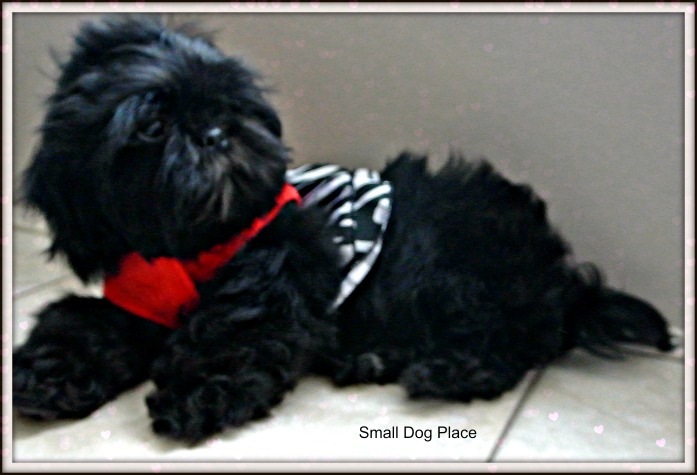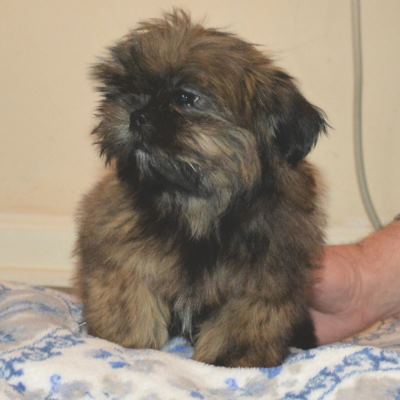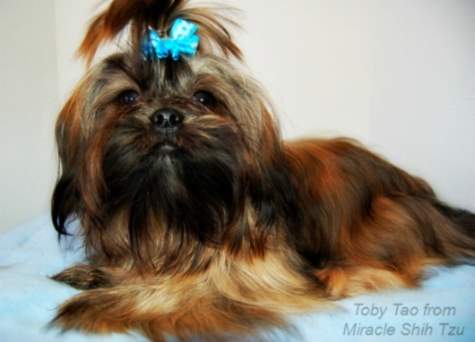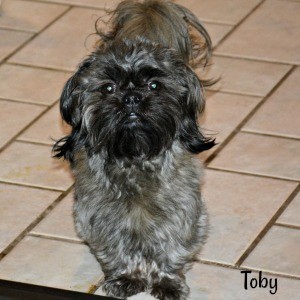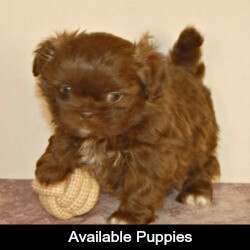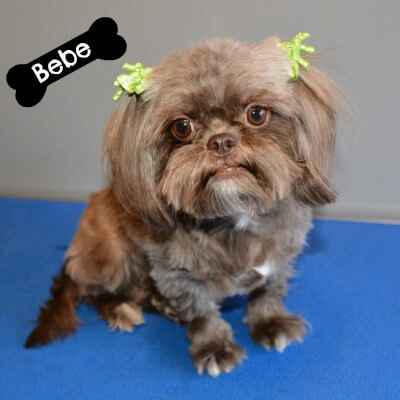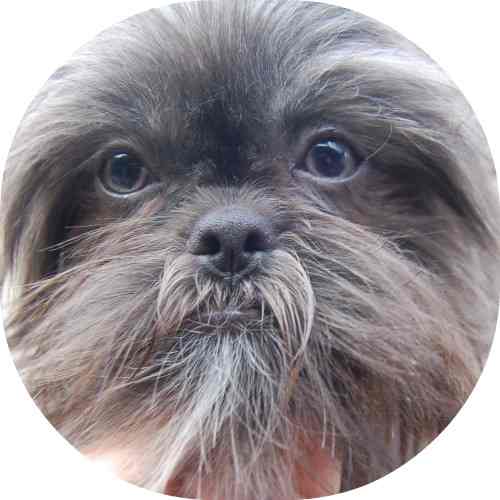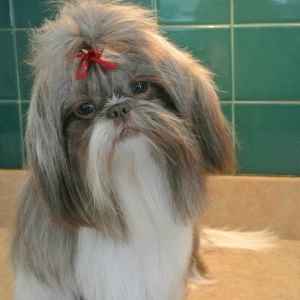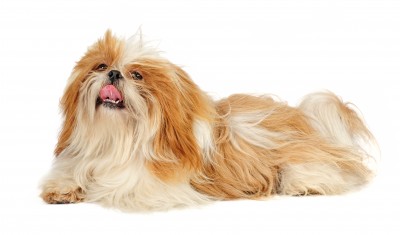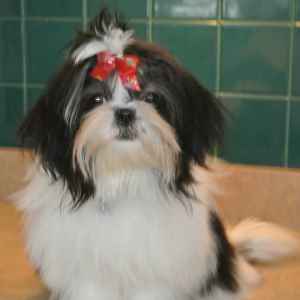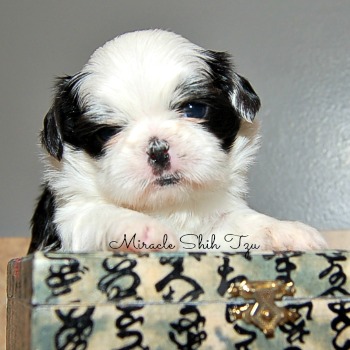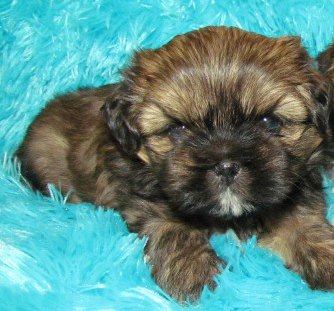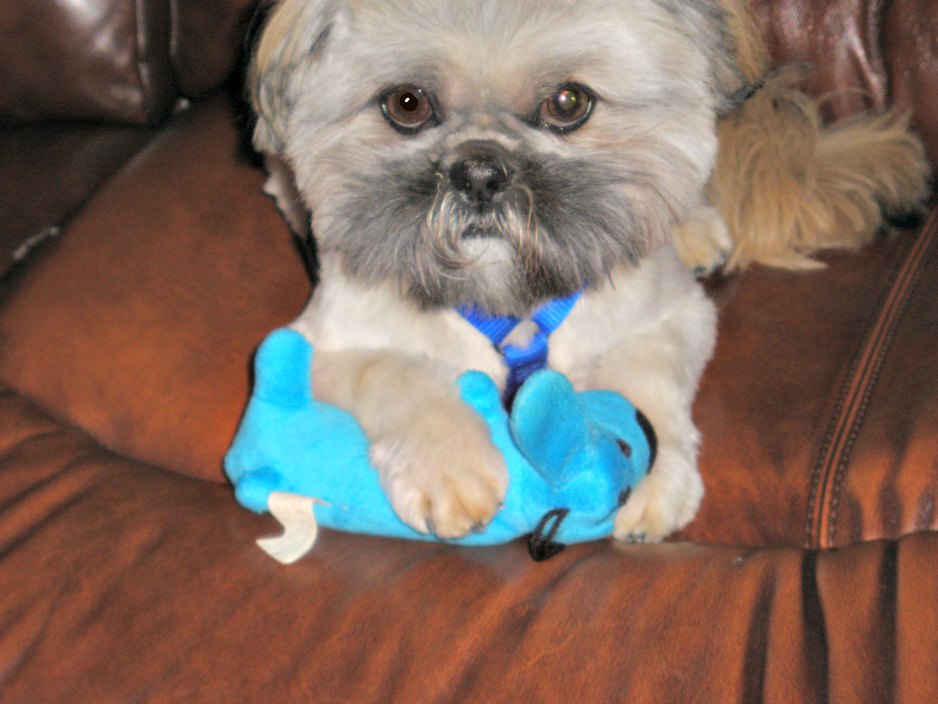- Home
- About the Shih Tzu
- Coat Colors
Shih Tzu Coat Colors: Complete Guide to Every Color & Pattern
The rainbow of Shih Tzu Coat Colors is a fascination for most Shih Tzu owners, and once buyers realize they have so many choices, that fascination often leads to an obsession. Some breeders will specialize on certain colors while others try to create a wide variety of colors.
"All Shih Tzu Coat Colors are permissible," states the breed standard by the American Kennel Club.
The Kennel Club in the UK, agrees.
"All colours permissible, white blaze on forehead and white tip to tail highly desirable in parti-colours."
In Canada, The Canadian Kennel Club states:
"All colours are acceptable, but black noses, lips and eye rims are a must."
According to the FCC (Fédération Cynologique Internationale)
"Colour: All colours permissible, white blaze on forehead and white
tip to tail highly desirable in parti-colours."
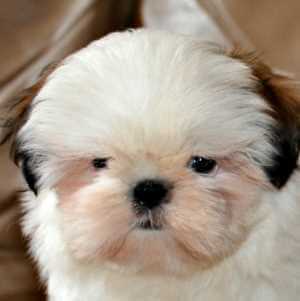 White
White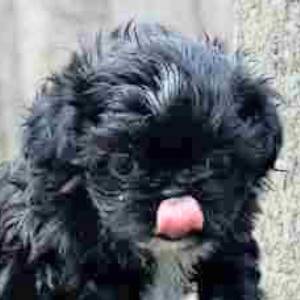 Black
Black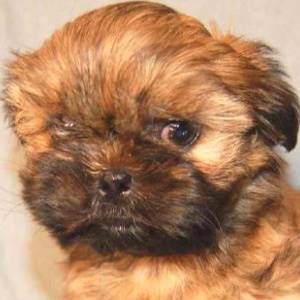 Red
RedSo, if every color is permissible, what colors are really available?
When a person first looks or think about a Shih Tzu dog or puppy, they see the gorgeous coats of many colors characteristic of Shih Tzu Show Dogs.
Unlike some breeds that are typically one color or a variety of a few colors, the Shih Tzu come in an amazing array of rich colors.
But with such a rich variety of Shih Tzu Colors, color combinations and markings comes a great deal of confusion. To make it even more confusing, a Shih Tzu's colors can change over time.
In this article about colors of Shih Tzu dogs, I will try to explain the many variations of colors that are present in the breed today and help you decide on your perfect Shih Tzu color.
BUT, please note that the color of the Shih Tzu does not make the dog! When purchasing a dog, look for health, personality and temperament.
How we Classify Coat Colors in the Shih Tzu Breed
Shih Tzu puppies can be born with a solid color hair, a combination of two colors, or a mixture of three colors.
To complicate matters worse, Shih Tzu dogs can be registered with the American Kennel Club, (AKC) based on the pigment of their skin rather than the color of their coat!
Can the “experts” make it any more complicated? Well, the short answer is yes and no. Understanding what is considered a specific color can be even more difficult if you’re as nearsighted as me, so how does one determine the color of a Shih Tzu dog?
If a puppy is going to be registered with the American Kennel Club, the breeder has a choice of eight solid colors, seven varieties of two color combinations, four combinations of three or more colors and a variety of different types of markings that occur with the combinations listed above.
A Word about "Official" and "Unofficial" Colors
As you search for a specific color you are going to encounter breeders that have many different names for colors that are not recognized by major kennel clubs.
Whether breeders use these colors as a way to describe the color in layman's terms or to justify highly inflated prices for unusual colors is still a debate in my mind. If you see colors such as:
- Chocolate
- Lavender
- Isabella
These are not standard colors. All of these colors would be labeled liver if your puppy was registered with the AKC.
Let us start with the solid colors. There can be eight solid colors from which to choose:
Shih Tzu Coat Colors: The Solids
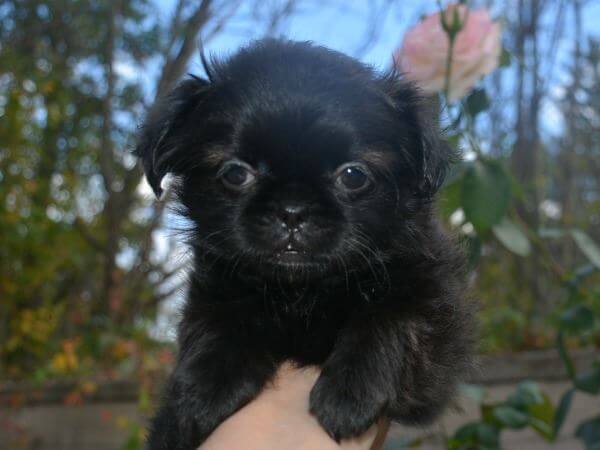 This solid black Shih Tzu puppy is also considered to be a Prapso
This solid black Shih Tzu puppy is also considered to be a PrapsoBlack is the most dominant color and a true black Shih Tzu will have no other hair color.
Even if there is a small trace of another color, the dog will then be considered to have a combination of two colors. All Shih Tzu dogs that have black hair will also have black noses. You will never see a Shih Tzu that is all black with a brown nose.
It does not exist. I've seen rumors circulating on the internet that Shih Tzu dogs that are black do not occur and that the puppy must be a hybrid. That is not true. There are completely black puppies just very rare.
A White coat is similar to black in that it only has one color with no traces of any other colors. The nose is black unless the dog is considered to be liver and then the dog will have a brown nose and be liver color.
The American Kennel Club makes it a bit difficult for breeders whose puppies and dogs are not a pure white but rather more cream than a white. There is no option to describe a Shih Tzu as cream, so white is usually notated on the official paperwork.
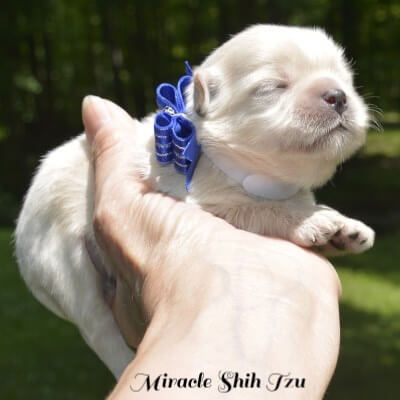 This puppy started life almost white and then turned silver by one year old.
This puppy started life almost white and then turned silver by one year old.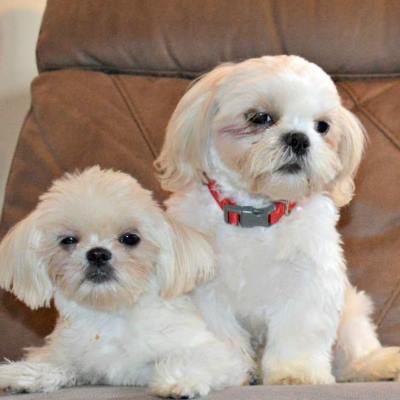 These two white Shih Tzu are Princess Leia and Obi Wan Tzu-nobi
These two white Shih Tzu are Princess Leia and Obi Wan Tzu-nobiA silver color coat tends to look white with a deep shine resembling silver. It is not grey, but rather a shiny, silky color. The dog will have black lips, pads, eye rims and a black nose.
Red is a solid color that looks deep, dark, orange. The dog's nose and other points (eye rims, pads, lips and nose) will be black.
Gold solid resembles a tan-yellow, but there are a wide range of shades from a light tan to a deep gold.
 Lilah is a solid gold with a black mask
Lilah is a solid gold with a black mask Hanna is Lilah's mom and looks almost identical.
Hanna is Lilah's mom and looks almost identical.Even though the two Gold Shih Tzu dogs above are daughter and mom, you can see the difference in the color shades with Lilah (left) looking more reddish.
Brindle is really a combination with one color and a streaking of another color running throughout such as a gold-black brindle. Toby, below is an example of a red- brindle Shih Tzu coat color. Brindle is really not a color but a pattern that consists of stripes of golds, tans, browns, grays or blacks.
Brindle coats all look different because in some dogs, the stripes are thicker or wider whereas in some coats the stripes appear to be very narrow.
If the brindle includes liver or blue, the dog will be considered liver or blue. A true brindle designation will have black points meaning black eye rims, mouth, and paw pads.
What appears to be a brindle coat when the puppy is very young can turn into something else as he matures.
The picture below of Toby is when he was about one-year-old. He had a beautiful red brindle coat. The picture of him at six years old looks very different. He is still brindle but has lost much of the red and the brindling is less obvious.
Brindling occurs as a complex reaction to several genes found at different locations (loci) on the gene.
Liver
Here are three different liver colored dogs but look different because they are called liver due to the brown pigment on their nose , eye rims, foot pads.
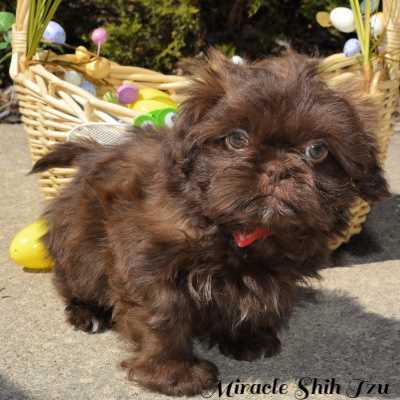
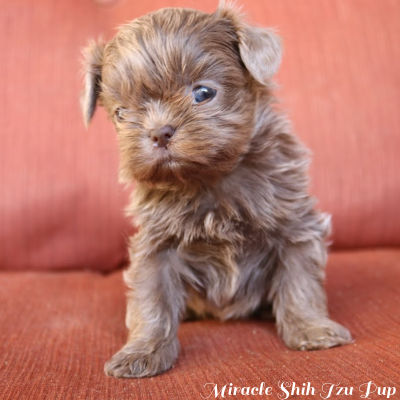
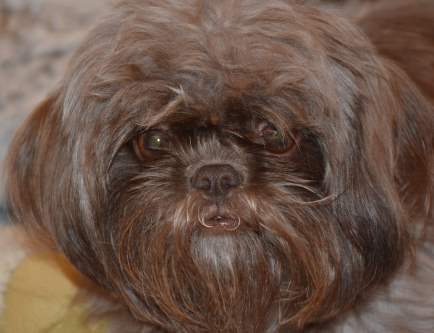 This is Bebe, a retired mama at Miracle Shih Tzu. She is liver.
This is Bebe, a retired mama at Miracle Shih Tzu. She is liver.Liver is confusing because it is the color of the points (the dog’s nose, eye rims, pads, and lips and not the actual coat color. Only when the points are a brown or liver color will the dog be labeled “liver.”
Liver colored dogs lack the black pigmentation of the skin. Their noses, pads on their feet and lips will be brown, but their hair may have other coloring, from very light to deep chocolate and everything in between.
Livers can range from light red, orange, and cream coloration to deep chocolate. So, you could have a white-liver, a cream colored-liver, a red-liver, or a chocolate liver.
Some Shih Tzu dogs may also have green eyes with this coloring, but not always.
The liver color comes from a recessive gene and for it to show up in a puppy, both mother and father must carry the gene.
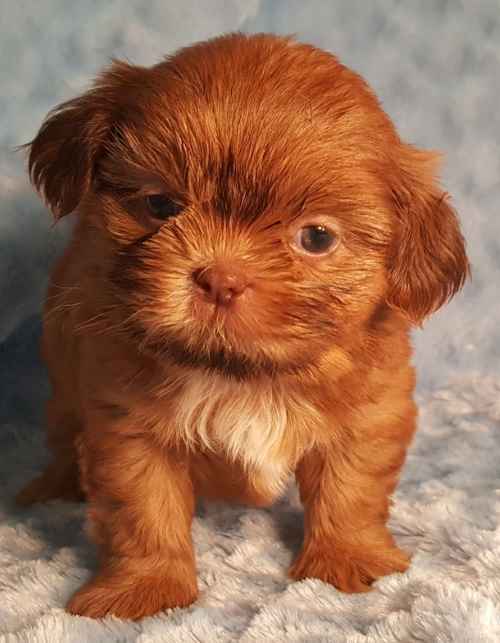 This lovely red Shih Tzu puppy would see, "liver and white," on his official AKC registration paperwork.
This lovely red Shih Tzu puppy would see, "liver and white," on his official AKC registration paperwork.Taco here from Dogwood Country Shih Tzu, has a stunning red color with just a bit of white on his chest. But look at his nose. Unlike the Red and White Shih Tzu above, little Taco's nose is brown.
Technically, the American Kennel Club will describe him as a liver, even though he has that distinct red color that often looks more orange than red.
Bebe, Young and Old
Gus's Amazing Color Change
Cathy Morning, from Bloomer, WI USA writes
Gus was a solid dark brown. At one his back turned what I am told a mocha. His face, legs and feet are brown.
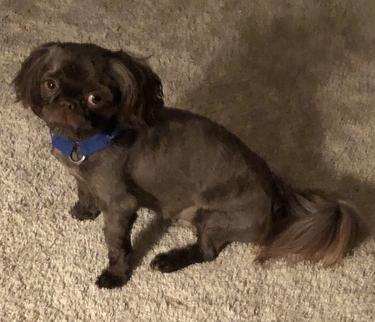 Gus with a deep chocolate-colored hair coat
Gus with a deep chocolate-colored hair coat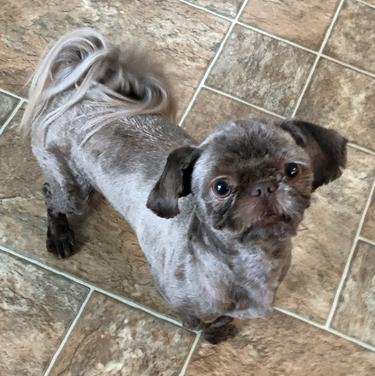 Gus Now
Gus NowBlue
Blue is another confusing color. A true blue Shih Tzu will have a blue nose, but can have other colors of hair. The color looks more charcoal and is often difficult to see except in natural light. Sunlight is the best way to observe this rare color.
So, if you are contemplating the purchase of a true blue colored Shih Tzu, it is best to visit the breeder personally rather than depend on a photo on the Internet.
Blue is considered to be a dilute from a genetics point of view. A dilution occurs when the pigment (either black or brown) has been affected by an additional dilution gene. When this occurs pigment is clumped differently and distributed irregularly.
If the pigment is black, then the dilution will result in the blue color. If the pigment is brown, the color that is produced is a silvery color called isabella or lilac. You will hear Shih Tzu breeders call this color, "lavender." AKC recognizes the blue but does not list the isabella or lavender color as part of their standard.
This dilution gene only affects the pigment of the nose, eye rims and other points. It has no effect on the coat color.
Shih Tzu Coat Colors:
Two Color combination
There are seven varieties of colors that contain two combinations, a white with another color:
- Black and White
- Blue and White
- Silver and White
- Red and White
- Gold and White
- Brindle and White
- Liver and White
Another Shih Tzu Coat Colors combination of two colors includes dogs with red and gold coloration but this combination does not appear on the official AKC Registration paperwork, even though it exists.
When there are two combinations, the color patterns can have endless possibilities. No two Shih Tzu with two colors will ever look alike. Symmetry in color combinations is highly desirable, but not necessary.
Liver and White Shih Tzu
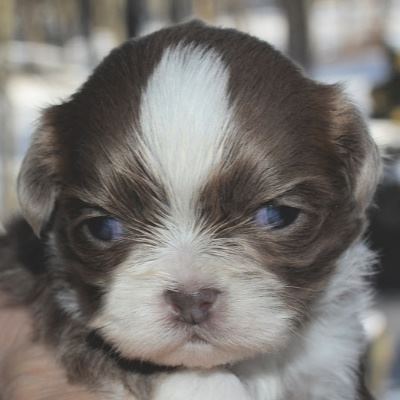
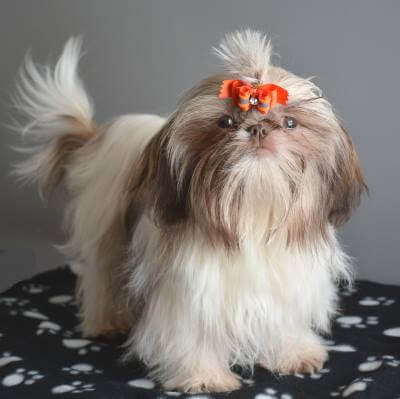 This is our retired sire, Ketchikan
This is our retired sire, KetchikanRed and White Shih Tzu
Here is a red and white Shih Tzu. The red looks orange to the eye but should not be confused with the lighter colored golds.
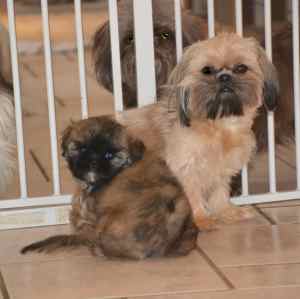 This is one of our former mamas and her pups.
This is one of our former mamas and her pups.Black and White Shih Tzu
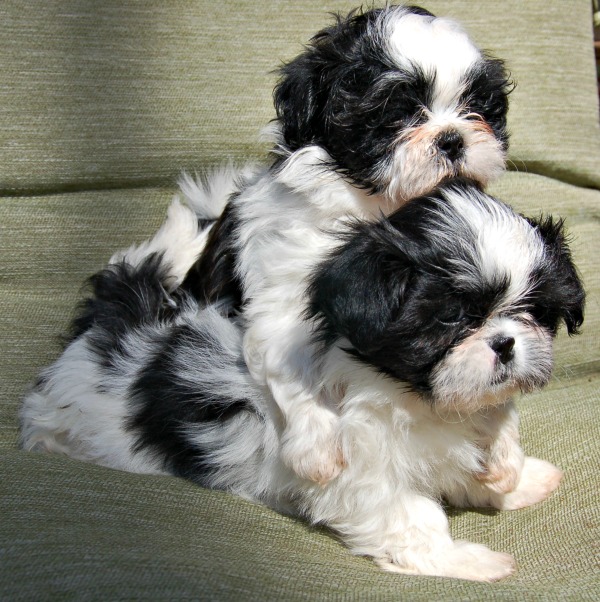 Two black and white siblings at 8 weeks of age.
Two black and white siblings at 8 weeks of age.Blue and White
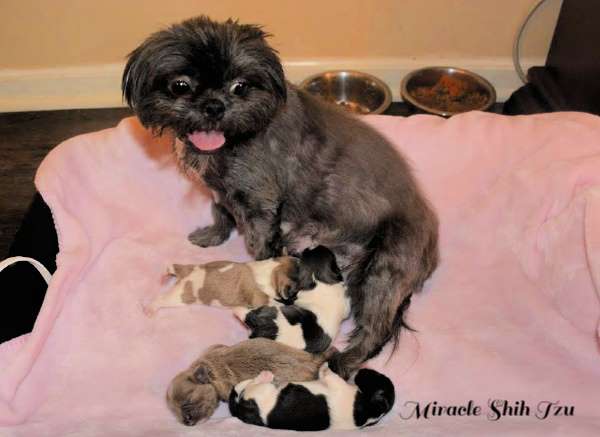 This former mama (Lucy) who is blue with her four puppies, two who are blue and white.
This former mama (Lucy) who is blue with her four puppies, two who are blue and white.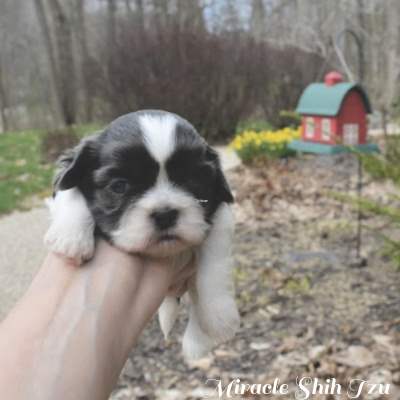 This is a Blue and White Shih Tzu puppy, the daughter of the dog pictured above.
This is a Blue and White Shih Tzu puppy, the daughter of the dog pictured above.A designation of black and white includes all dogs with black and white markings. A term that you may see come up from time to time is piebald.
The white that appears on a black and white dog is determined by the gene on the S locus. White spotting or white areas are basically the same and can occur on any color including black. The white hair occurs when the skin cells cannot produce any pigment resulting in a pinkish skin and white hair. The nails and paw pads may also become white or pick where there is not pigment produced.
Some of the more interesting patterns we see in Shih Tzu dogs occur in the black and white ones. See patterns below.
Lilibeth, from Midland TX writes
She is still a puppy so I haven’t noticed a change in her coat yet, but I’m sure I will, her dads coat turned into more of a silver and white coat, and he had way more black on him, her mom however is black and white and although the white spread far out, the black stayed pretty black. I’m excited to see what she looks like as she grows.
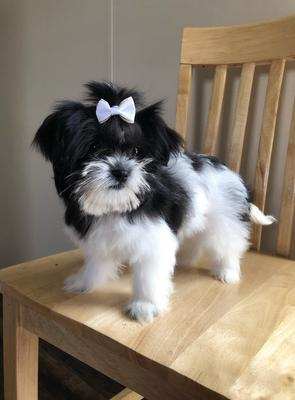
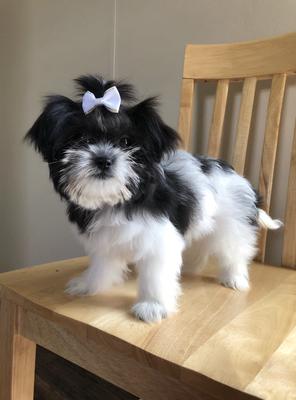
Shih Tzu Coat Colors: 3 Color Combinations
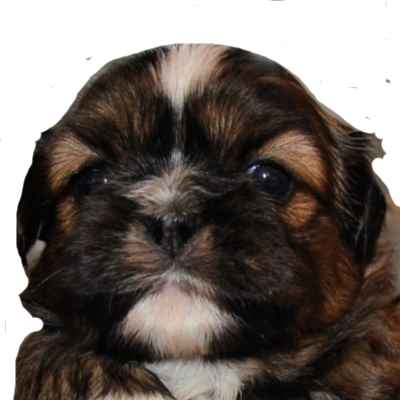 Three color combination with Dobie Markings
Three color combination with Dobie MarkingsShih Tzu dogs can also have a combination of three colors. The most common combinations of these include:
- Silver, Gold and White
- Silver, Black and White
- Black, Gold and White
- Black, Silver and Gold
Black, Gold White
By: Claudia, From Sto. Dgo. Dom. Republic writes,
When I first met her (8 weeks) she had 3 colors, black, white and gold). Her groomer never shaved her coat until 14 months. She is now 16 months and her coat is now a Beautiful pattern of colors. I'm enjoying the journey and love her no matter what.
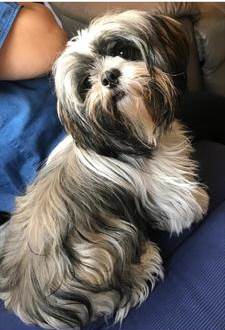
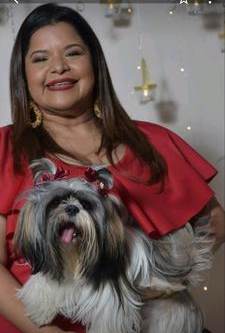
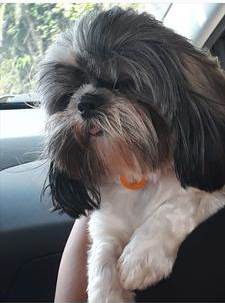
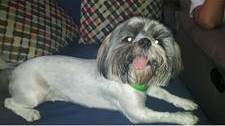
Unique Markings
In addition to the Shih Tzu coat colors, and combinations, certain markings on the fur can occur. Each has its own terminology.
Black Mask
You might think of the Lone Ranger or Batman, but the mask on a Shih Tzu is quite different. Sometimes a dog will have a black coloring of hair on his muzzle which may extend towards his eyes and on his ears and even up towards his forehead.
This is called a black mask. The rest of the hair can be another color such as gold or red.
Dobie Markings
A very rare colored marking called Dobie markings occurs when a puppy is born with tan markings on an otherwise black or very dark coat. This would be in addition to the normal Shih Tzu Coat Colors mentioned above.
These markings can be found above the eyes, on the jowls, on the lower legs, and under the tail. This is considered very rare and breeders will often sell these pups at a premium.
They are called "dobie" markings because they resemble the coloration seen on the Doberman Pinscher. These colors and marking are relatively rare since they come from recessive genes, meaning that both parents of a puppy must “carry” that recessive gene for the puppy to have that color or marking and not all puppies from those parents will show the dobie marking.
Black Tips
Another interesting occurrence in hair color is black tips. When the puppy is born, the coat is one color such as red or gold with black tips at the ends of the hair shaft.
This occurs over the body and should not be confused by the black that some Shih Tzu dogs have on their ears. This black tipping disappears entirely after the puppy's first hair cut, but is very striking and beautiful when the dog is young or if the dog remains in full coat.
Claire from Oviedo, Florida (USA) Writes about her Lola who was gold and white with black ear tips at 16 weeks:
I don't have a picture of her as a puppy that's good enough to post but her gold has darken to a greyish tan. After her first grooming the black ear tips were gone and I was sure the groomer was giving me someone else's dog. This is her at 7 years old. At 9 years old she seems to be getting lighter on her saddle and ears!
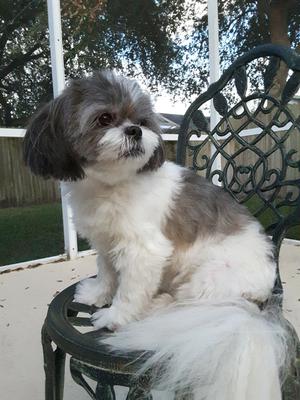
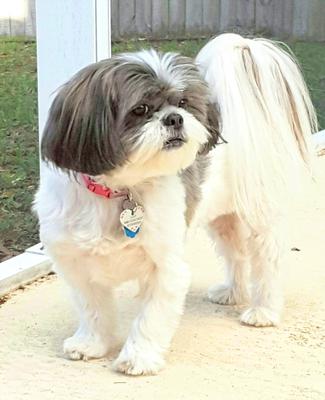
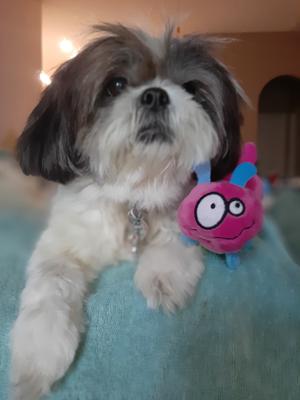
Shih Tzu Coat Colors: The Perils of Time and How Colors Change
One of the fascinating traits of the Shih Tzu breed is the possible change in coat color as they mature. This metamorphosis is primarily attributed to the breed's unique gene structure, which causes a progressive graying or lightening of the coat as the pup ages. The changes might happen during their first year, but sometimes continue until they're around two years old.
Puppies born in black and white might retain their black markings, but oftentimes, the black gently fades into a silver or gray. Dark brown (also known as chocolate or liver colored) puppies can retain their coat color, or it may lighten to a creamy beige. The "red" Shih Tzu (a deep golden color) might get lighter, but rarely turn completely blonde. The best way to know if your puppy will change is to ask the breeder.
Shih Tzu puppies that are born a solid color, especially black, are the ones that most often keep their color throughout their lives. Meanwhile, gold and light colored ones are often likely to lighten as they age. It's also common for a Shih Tzu to have a glorious, multi-colored coat as a puppy, only to transition to a completely different hue when mature.
Sometimes a Shih Tzu may develop "ticking," which are small spots of color on a white area of the coat, and these generally start to appear around the 1-year mark.
It's important to know that these color changes are entirely normal and don't signify any health issues. However, sudden or extreme changes in an adult Shih Tzu's coat color can signal health issues and should be checked by a veterinarian.
Learn more about Shih Tzu Changes in Coat Colors
More Genetic Factors that Contribute to Coat Color
Fading: If a Shih Tzu carries the "G" gene, his coat will fade as
he gets older. You will notice fading in puppies as young as a month
old. Sometimes puppies look like they are almost black at birth but by
the time they get their taste of dog food for the first time, their coat
has changed. Fading will continue until the dog reaches his first
birthday.
Graying: If a dog carries the Chinchilla gene
(CH series) he is likely to change colors as well, but not in the same
way as fading. Instead, the dog's coat will turn a rich, silver color.
Someone once asked me if my dog was aging prematurely at two. No, its
just that gene at work!
8 Week Old Puppy
Here is Ricky at 8 weeks old. He has black tips but its difficult to see in this photograph.
His coloring is very dark, almost brindle in color with a black mask.
Adult Dog
Here is Ricky again all grown up. Same dog, but his color is completely different. He has retained his black mask, but all black tipping goes away with the first haircut.
More Interesting Shih Tzu Coat Colors and Patterns
You will hear all sorts of terms used to try and describe the may ways that colors fall on the coat. Here are just a few:
Blaze: refers to a strip of white hair right up the center of the face, between the eyes
Flare: this occurs when the blaze (above) widens as it approaches the top of the skull.
Collar or shawl: As the name suggests, it is the marking around the neck which is usually white.
Saddle: A large patch of color, often white, over the back where a saddle would go if it were a horse.
Tuxedo: This is an interesting design where a white patch of hair can be found on the chest of an otherwise solid colored dog. The color is often on the chin and sometimes on the feet. When you put it all together, it resembles a Tuxedo!
Does Shih Tzu Coat Color Affect Health?
I have been asked this question many times, especially those that were considering a white Shih Tzu dog.
Research on health issues specifically related to different
coat colors in the Shih Tzu breed are limited and inconclusive. However, some
research regarding dog breeds more generally suggest a possible link between
certain colors, pigments, and health issues, but it is far from universally
adopted or agreed upon.
For example, there is a belief among some breeders that dogs with dilute colors
(like blue or fawn, which is a dilution of the black color) may be prone to a
skin condition know as Color Dilution Alopecia (CDA). This is a genetic
disorder that can cause hair loss and recurrent skin inflammation. It mostly
occurs in dogs with the diluted pigment (blue, gray, etc.) in their coats,
hence the name.
I wondered about this with a dog, Lucy I had purchased from a breeder in Ohio, who was all blue and ended up becoming bald. As a breeder, I was very worried and got her tested for anything that might be causing her to lose her hair, including thyroid hormone. All tests came back negative. Still, I worried that perhaps she should not contribute to the gene pool, so I decided to spay her and rehome her. She found a wonderful home in Cleveland, Ohio. Later, I learned that she regrew all of her hair and had a very thick, lovely coat. Was it CDA? Was it the stress of pregnancy and lactation?
Another topic that comes up sometimes is the association between white or
lighter-colored dogs and deafness. Some studies have suggested that breeds with
white or merle coat colors have a higher incidence of deafness (Strain GM, 2004. However, it
is important to note that the study includes specific breeds and may not be
universally applicable across all dog breeds.
It should be noted that Shih Tzu dogs can and do become deaf. As of this writing, I live with a dog, Cooper, who is deaf, but he is tricolored, black, white and brown.
It is crucial that breeders and potential owners understand that the color of a
Shih Tzu's coat should not be the determining factor in predicting health
risks. Regular vet check-ups and care from a responsible breeder play a vital
role in ensuring the dog's health more than any potential coat color related
risks. Always consult with your vet regarding any health issues with your Shih
Tzu.
The Genetics Behind All These Colors: Beginner's Guide to Dog Coat Colors
Understanding dog coat color genetics might seem complicated at first, but don’t worry! You don’t need a science degree to grasp the basics. Let’s break it down step by step.
What Are Genes & How Do They Work?
Genes are like tiny instruction manuals inside a dog’s body. They tell the body what color the fur, nose, and skin should be.
- Every dog gets two copies of each gene—one from mom and one from dad.
- Some genes are dominant (stronger) and override weaker genes (recessive).
- Some genes are recessive (weaker) and only show up if the dog inherits them from both parents.
Pigments
The Two Main Pigments That Create All Dog Colors
All dog coat colors come from just two main pigments:
Eumelanin (black pigment) → Creates black, brown (liver), blue (gray), and isabella (lavender) coats.
Pheomelanin (red pigment) → Creates gold, cream, tan, and red coats.
Every single coat color in dogs is just a mix of these two pigments!
What is a Locus /Loci?
A locus is like an address on a chromosome where a specific gen is located.
- Locus (singular) = One specific location of a gene on a chromosome.
- Loci (plural) = Multiple locations where different genes exist
- Each locus controls a different trait (coat color, nose color, white spots, mask, etc.).
- Each coat color gene sits at a specific locus (location) on a chromosome.
- Scientists have labeled these locations with letters to make it easier to understand. (Example B-Locus, D-Locus)
Important Loci for Shih Tzu Coat Colors
Different dog breeds have their own important loci to account for their hair color. Here are the ones that are recognized as occuring in the Shih Tzu Breed.
🔹 B-Locus (Black/Brown Locus) → Controls whether a dog is black or liver.
🔹 D-Locus (Dilution Locus) → Controls if the coat fades to blue or silver.
🔹 E-Locus (Extension Locus) → Controls gold, red, and black masks.
🔹 K-Locus (Brindle Locus) → Controls whether a dog has brindle stripes.
🔹 S-Locus (Spotting Locus) → Controls white markings & parti-color patterns.
Each of these loci has two versions (alleles)—one from mom and one from dad.
What are Alleles?
I'm sorry, so many vocabular words. I hope I haven't lost you yet. Let's break down alleles in the simplest way possible so it's easy to understand, especially in relation to dog coat colors.
What Are Alleles?
- An allele is a version of a gene.
- Each dog gets two alleles for every coat color gene—one from mom and one from dad.
- These alleles can be dominant (stronger) or recessive (weaker).
- Different alleles create different coat colors, patterns, and markings in dogs.
B Allele (Black vs. Liver)
| Allele Combination | Coat Color | Nose Color |
|---|---|---|
| BB (Two black alleles) | Black | Black |
| Bb (One black, one liver) | Black (carries liver gene) | Black |
| bb (Two liver alleles) | Liver (brown) | Brown |
Important:
The B allele (black) is dominant → Even if a dog has only one B, it will be black.
The b allele (liver) is recessive → A dog must get bb (two copies) to be liver-colored.
For Example:
If two black dogs (Bb) have puppies, some puppies may be black (BB or Bb), and some may be liver (bb).
D Allele (Dilution Gene – Blue, Silver, & Isabella)
| Allele Combination | Coat Color Effect |
|---|---|
| DD (Two normal color alleles) | Full black or liver color (No dilution) |
| Dd (One normal, one dilution allele) | Normal coat color, but carries dilution (can produce diluted puppies) |
| dd (Two dilution alleles) | Black fades to blue (grayish coat); Liver fades to isabella/lavender |
The D-locus controls pigment intensity, meaning it determines whether a Shih Tzu's black or liver pigment remains full-strength or fades to a diluted color (blue or isabella/lavender).
- A Shih Tzu with DD or Dd has full-strength color (black or liver).
- A Shih Tzu with dd (two dilution alleles) will have a faded, diluted coat:
- Black fur will fade to blue (a grayish color).
- Liver fur will fade to isabella (also called lavender, a pale brownish color).
- This dilution affects both the coat color and nose color.
How This Might Look
- The D-locus does NOT create new colors—it only dilutes existing ones.
- Black Shih Tzus with dd will turn blue (grayish).
- Liver Shih Tzus with dd will turn isabella/lavender.
- If a Shih Tzu carries one D and one d (Dd), it looks normal but can pass dilution to puppies.
E Allele (Gold, Red, and Black Masking)
| Allele Combination | Coat Color Effect |
|---|---|
| EE (Two normal extension alleles) | Black, brindle, or liver coat (if B-locus allows) |
| Ee (One normal, one recessive red allele) | Black, brindle, or liver coat, but can produce gold/red puppies |
| ee (Two recessive red alleles) | No black in the coat! Dog is gold, red, or cream, but nose remains black or liver |
How the E-Locus Affects Shih Tzu Coat Colors
- A Shih Tzu with EE or Ee will have black pigment in the coat if the B-locus allows it.
- A Shih Tzu with ee (two recessive red alleles) will have no black in the fur at all! These dogs will be gold, red, cream, or tan, but their nose and eye rims will still be black or liver based on their other genes.
- Black-masked Shih Tzus (with a dark face) have at least one E allele, which allows black pigment to be visible.
- Gold or red Shih Tzus (with no black hairs) always have the ee genotype.
How This Might Look
- Black-masked Shih Tzus must have at least one E allele.
- Gold, cream, and red Shih Tzus have ee (no black in the fur).
- The E-locus does not change nose color—nose color is controlled by the B-locus.
K-Locus Table (Brindle & Solid Coat Colors)
| Allele Combination | Coat Color Effect |
|---|---|
| KK (Two dominant alleles) | Solid black, liver, or diluted colors (prevents brindle pattern) |
| Kk (One dominant, one brindle allele) | Solid black, liver, or diluted colors, but can produce brindle puppies |
| kk (Two brindle alleles) | Dog is brindle! Base coat is gold, red, or tan with black or liver stripes |
How This Affects Shih Tzu Coat Colors
- A KK or Kk dog will NOT be brindle—it will have a solid coat.
- A kk dog will have brindle stripes, meaning its coat will be gold, red, or tan with black or liver streaks.
- If a brindle dog also has dilution genes, the stripes may turn gray (blue brindle) or isabella brindle.
S-Locus Table (White Spotting & Parti-Color)
| Allele Combination | Coat Color Effect |
|---|---|
| SS (Two solid color alleles) | Solid-colored coat with no white markings |
| Ss (One solid, one white spotting allele) | Solid coat with small white markings (chest, paws, or face) |
| ss (Two white spotting alleles) | Parti-color! Large white patches with any other color (black, gold, liver, etc.) |
How This Affects Shih Tzu Coat Colors
- A SS dog will be a solid color (no white patches)
- A Ss dog will have small white markings, often on the chest, paws, or forehead.
- A ss dog will be parti-colored, meaning it will have large white patches combined with another color.
- Parti-color combinations include black & white, gold & white, liver & white, and more!
Why Do Shih Tzu Puppies Change Colors?
Many Shih Tzus are born one color and change as they grow. This happens because of:
- Fading Gene (Progressive Graying) → Some puppies lighten with age (e.g., black fades to silver, red fades to gold).
- Dilution Genes → Cause blue, silver, or isabella coats.
- Brindle Changes → Black stripes may fade, leaving a mostly gold coat.
Example: A black puppy might turn silver or even light gray as an adult!
Tip: Look at the color of the ears—this often hints at what the final color will be.
Choosing A Shih Tzu Coat Color
So how does one choose a color? It is really all about personal preferences. A light colored coat will require more bathing and grooming. A white coloration on the face, around the muzzle or under the eyes can stain easily and will require frequent washing. You will likely be dealing with tear staining.
Products that eliminate tear stains may be necessary in these light colored Shih Tzu. Chocolates are “hot” now and rare colors are more expensive. Colors are beautiful, but hair and point colors are only “skin deep.” The true personality and amazing characteristics of the breed goes deep and comes in any color! Different Shih Tzu coat colors are fascinating for current and future owners. If you are curious about how colors change over time, don't forget to visit our page on Shih Tzu coat color changes.
Do Shih Tzu coat colors change as they age?
Do Shih Tzu coat colors change as they age?
Some, but not all Shih Tzu may experience a coat color change during their lifetime.
What is the rarest Shih Tzu color?
What is the rarest Shih Tzu color?
There are no true rare colors, just ones that are not accepted by AKC.
Does color affect a Shih Tzu’s health or personality?
Does color affect a Shih Tzu’s health or personality?
There is no evidence that a Shih Tzu's coat color affects their health or personality in any way.
Did You Know...
Many people choose a name based on their Shih Tzu Coat Color. For example, check out our Shih Tzu Names Pages to learn more.
Tell Us About Your Shih Tzu's Coat Colors
What Color is Your Tzu, Now and as a Puppy? Have something to Say?
Have something to say about Shih Tzu Coat Colors? Tell us about your dog's coat, color, texture? Did your Tzu's coat colors change over time? Were you surprised? What is about your Tzu's coat that you love? What is it that you would change if that were even possible? Don't forget to add some pictures. After all, a picture is worth a 1000 words.
What Other Visitors Have Said
Click below to see contributions from other visitors to this page...
Blasto my Liver Shih Tzu Boy 




Blasto changes color over time as you have seen in the pictures.
Maggie my multi coloured Shih Tzu girl 




I re-homed my multi coloured pup from a couple who could no longer give her the attention she needed.
She isn’t KC registered but was told that both …
Muffin and the Color Changing Coat 




When we first adopted Muffin, she was this beautiful brown and black mixture. Mostly a dark brown but with a black stripe on her back and muzzle, hence …
I think Theo is brindle but I'm not sure. 




Theo is a rescue I adopted I'm just curious what color he would be classified as. His nose is dark brown with a chocolate spot in the center and he looks …
Popo the cutest Shih tzu you will ever see 




Our puppy is red and white with a touch of black on face, ears and tail. His red and white is very symmetric. We have had him for almost 2 months. He is …
Is this dog a Shih Tzu? 




Lil black sheep is our only black Shih Tzu, the other five are black and whites. However I don't think our blackie is a Shih Tzu, I think he looks mixed …
Mrva Two Color Mummy 




Recently Mrva became a mummy! We have puppies all different colors. Two colors and three colors. :)
-------------------------------------------
Hi, …
Teddy-Shih Tzu boy Not rated yet
Teddys coat color changed so much over the 18 months of his life. He has never been clipped other than trimming has face and sanitary clippings. His underbelly …
Dahlia Noir my Black Tuxedo Girl (CH) Not rated yet
At 8 weeks she was black with white tuxedo/socks and with dobie brown on her back knees. Her silky hair was floor length .
At 5 months she is pure …
Colour Enquiry of Pups and my Dogs mother! Grey Not rated yet
Colour Querie.
Glory my female was true Brindle, three colours with black tips as puppy, became red at 6 months then more Grey.
She has a Silver, blue-Grey …
Pepper, my black beauty Not rated yet
He was all black rxcept for a white bib when he was born. The bib has disappeared completely but he has silver in his tail and hind quarters.
Takeyia, a Tri-color Shih Tzu Not rated yet
She was 3-4 different colors when she was born. My dad nicknamed me Littleheart when I was little, and I picked Kia because she had three patches on her …
Mandu my Blue or Grey Shih Tzu Boy Not rated yet
What color is he?? And why does he have curls? My two-year-old boy has a brother from the same litter that has tan and black straight fur! They do not …
Toby the Shih Tzu's Color Changes Not rated yet
My dog Toby started off very dark. His dad was a blue brindle according to the breeder. At 1, he is now grayer in color.
---------------------------------------------- …
Youpi my tricolor Shih -Tzu Boy Not rated yet
Youpi had more white on chest and paws and back and even his tail when he was one month old.At 2 months and half he changed I don't see that beautiful …
Sophie Grace my Imperial Red and White Not rated yet
Sophie had a pattern on her that made it look like she had wings on her back. I called them her angel wings. Unfortunately, she gained her true angel wings …
My puppy shihtzu Not rated yet
Hi, my little girl has had some puppies and one of them I'm just stuck with what colour he is please could you help, please.
------------------------------------------ …
Maggie My Black Shih Tzu Sweetheart or Lhasa? Not rated yet
I am glad to read some posts about Shih Tzu colors that eventually encouraged me to share my story here. Maggie is my 3-month-old Shih Tzu.
I am confused …
Little Black, Brown and White Shih Tzu Girl Not rated yet
Hi, my dog is eight weeks, and she is black, white and brown. I would like her to remain this way, do you think she is going to change?
------------------------------- …
Empress Wang Muzhi My Brindle Female Black Mask ShihTz Not rated yet
She has a white chest, white wings on her back and a small patch of white down the middle of her forehead.
She also has a black mask with a little white …
Rolo, my Shih tzu boy Not rated yet
Hi could you tell me what colour my dog is classed as, He has a few different beautiful colours but never been sure what colour he actually is classed …
Holly my crazy Shih Tzu: Color Changes Not rated yet
Holly started out at 6 weeks with mostly black, gray, and white. Now she is almost all white but she has black hairs scattered throughout her coat. Her …
Chloe-- shih tzu/poodle mix. Not rated yet
This is Chloe :) born white and brown and faded over time. For a mix she shows more of the shih tzu coat. Even 1/4 shih tzu (strong "g" genes!!!) color …
Blue Gonzalez Alvarez my gold and white sweet Puppy Not rated yet
Blue was born on January 19th of 2016 with a beautiful white and light gold color -- deep glittery green eyes!!
He is a sweetheart and even though …
Moose as he faded Not rated yet
Moose was born of a black and white mother and a gold and white father. He was born and listed as tri color. As he got older, the beautiful patch over …
Bandit my black shih Tzu boy Not rated yet
Bandit was and still is jet black. At birth, he had a black shiny coat. He has a twig of white on his tail and a few sprigs of white on his chest. Bandit …
Lacey my chocolate girl Not rated yet
I bought Lacey at 9 weeks,as I loved the deep colour chocolate brown, but at 5 months, she started changing, and now at 8 months she as grey streaks ,running …
"Hi, I'm Janice Jones, a former veterinary technician and Shih Tzu expert with over 40 years of experience with the breed. Through Miracle Shih Tzu, I combine my medical background and extensive breed knowledge to provide reliable, practical advice for Shih Tzu owners. My mission is to help you give your Shih Tzu the happiest, healthiest life possible through evidence-based information and real-world solutions. Whether you're new to the breed or a seasoned owner, you'll find trusted guidance here for all aspects of Shih Tzu care.
I hold an undergraduate degree in Psychology with a minor in biology, Early Childhood Education, and Nursing, and a Master's in Mental Health Counseling.
